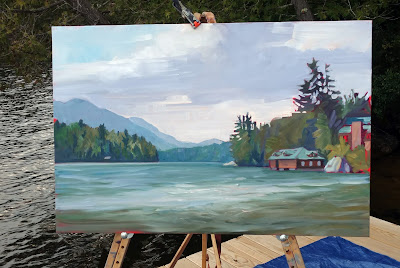The modern plein air movement is only about 30 years old. How is it changing art?
 |
| Not nearly finished…36X24. |
I worked on one painting all day yesterday, carefully, methodically and in a focused manner. The Adirondacks are in an unstable weather phase, so I was forced off my dock three times by electrical storms. Still, I spent a solid six hours on this one painting. I expect it will take that much again to finish—if I get that time without another storm.
This is a new approach for me. I’m working bigger, slower, and more deliberately. Rushing to make many small works sometimes like writing postcards. The difference makes me wonder how plein air events shape the way we work.
| Rocky, for Cape Elizabeth Land Trust, took me 2.5 days to finish. |
It’s easy to forget how new modern plein air culture is. In 1985, painter Denise Burns formed Plein-Air Painters of America (PAPA). The next year, her group started an annual exhibition on Santa Catalina Island. The discipline has exploded in popularity with both artists and collectors. Plein air painting is accessible and comprehensible. The Art Establishment may look down on it, but the typical punter loves it.
Today there are hundreds of these events nationwide. There are also nomads whose profession is to participate in them. But these events are very different from getting together with your pals at the town park. For example, I never would have forced my work through a line of storm squalls if I were at home. I could return when the light matched my start, rather than struggling to finish in sub-optimal conditions. In fact, I could work an hour a day for a week on one painting, if I wanted to. None of these options are available for the event painter. We must work fast.
| Towering Elms, for Castine Plein Air, only took me half a day. |
Festival deadlines give rise to a fast landscape style as inexorably as the Internet has given rise to the 500-word blog post.
According to the Van Gogh Museum, Vincent Van Gogh “put a great deal of preparation into The Potato Eaters, his first large figure study, working on dozens of preparatory studies. The final painting took ‘many days’ to complete, spread over a longer period of time. However, during the last two months of his life in Auvers-sur-Oise, Vincent completed a painting every day.”
Clearly, that kind of pace can drive you nuts.
 |
| Dry Wash, for Santa Fe Plein Air, took the better part of a day. |
As a youth, John Constable was a dedicated rambler, sketching in the Suffolk and Essex countryside. These scenes, he said, “made me a painter, and I am grateful.” But this was a low-brow form of education for the time, and the art establishment suggested he not give up his day job. Constable always maintained a strict division between his loose field sketches and his finished paintings.
Paul Cézanne, of course, didn’t have a car to dump his gear into and go. Instead, he painted Mont Sainte-Victoire more than eighty times, from various vantage points. Most frequently, he worked from what is now known as the Terrain des Peintres. It was close to his studio.
Tom Thomson was transformed into a landscape painter through his intimate relationship with Algonquin Park. His patron, Dr. James MacCallum, said that Thomson’s paintings “made me feel that the North had gripped Thomson as it had gripped me since I was eleven when I first sailed and paddled through its silent places.”
The modern plein airpainter doesn’t generally develop that deep relationship with a particular place. On the other hand, we are forced to paint very fast, and that often results in a different kind of energy and verve. And it’s always fresh. We, like our society, are constantly on the move. That’s making a new kind of art.
